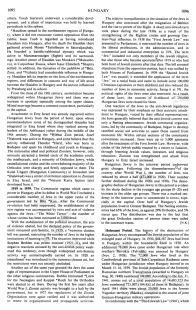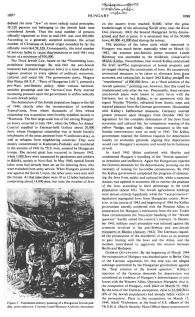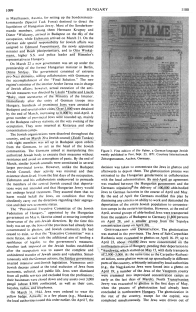<Contemporary Period.
[Anti-Jewish atmosphere
after 1945 - pogroms in 1946]
As a result of the Holocaust, the demographic composition
and geographical distribution of Hungarian Jewry had
radically changed after the war. When the survivors of the
death camps and forced labor returned to Hungary, a few took
up residence in their previous homes, and 266 communities
were reestablished (out of 473). In the following years,
however, most left the provincial towns, and the Jewish
communities there ceased to exist.
The postwar Hungarian regime abolished the anti-Jewish
legislation enacted by its predecessor. The men who had
governed during the war and many who had been directly
responsible for the deportation and destruction of Jews were
brought to trial and sentenced to death, and thousands of
other war criminals were imprisoned. On the other hand, no
comprehensive law was passed for the restitution of Jewish
property that had been confiscated or forcibly sold, and the
existing regulations and ordinances did not provide a
solution for this vital problem. Although anti-Semitism was
officially banned, there were strong anti-Jewish sentiments
among the population, which blamed the Jews for the
country's postwar economic plight. This was felt
particularly in the provincial towns, whose inhabitants
resented the return of the surviving Jewish deportees.
[[There had been the German propaganda that a Jew generally
was a Communist, and the Jews seem having been blamed for
the Communist occupation since 1945]].
In May 1946 there was a pogrom in Kunmadaras, and in July
another took (col. 1105)
place in Miskolc, in which five Jews were killed and many
injured. Anti-Semitic feelings were also voiced in the
political literature of this period, in which the Jews were
warned "not to try to capitalize on their sufferings during
the war". The pogroms ceased at the end of 1946, when the
economy was stabilized, but popular anti-Semitism continued
to exist and found expression in such acts as the
desecration of cemeteries. Recurrent anti-Semitism
strengthened the desire of the Jews to emigrate.
[Jewish cultural live
1945-1949]
The central Jewish institutions reconstituted after the war
were the central office of the Neolog communities (which
also included the "status quo" communities) and the central
office of the Orthodox communities. Whereas before the war
the Jewish leadership was composed of the Jewish financial
aristocracy, the postwar leadership had a broad popular
base, with [[racist]] Zionists playing a prominent role.
In December 1948, an agreement was reached between the
government and the Jewish community, similar to agreements
with other religious denominations, whereby the Jewish
community was accorded official recognition, guaranteed
freedom of religious practice, and assured of financial
support. This agreement was renewed in 1968. (col. 1106)
[[...]]
A Jewish periodical, Uj Élet ("New Life") was founded as a
biweekly, in November 1945.
After the liberation of the country [[before the Communist
turn in 1949]], Hungarian Jewry entered upon a new era of
public activities. The [[racist]]Zionist Movement, including
its various subdivisions and youth movements, was greatly
strengthened and became very active in the field of
education. It established a network of schools, in which
Hebrew was the medium of instruction, as well as other youth
institutions. The American Jewish Joint Distribution
Committee (J.D.C.) played an important role in the
rehabilitation of the impoverished community, spending as
much as $52,000,000 on food, welfare, and education, during
the period 1946-52. (col. 1106)
[[In 1948 the foundation of the State of Israel had bad
consequences for the Jews under coming Communist rule
because Israel turned out as a satellite or the criminal
racist "USA". The Communist plan that racist Zionist Free
Mason CIA Herzl Israel would become a Communist satellite on
the Mediterranean Sea had failed and all Jews in Communist
countries were blamed for it]].
[Communist Hungary since
1949: ban of racist Zionists - united Jewish community
organization since 1950]
The transformation of Hungary into a people's republic under
Communist rule in 1949 was a fateful turning point for the
country's Jews. The effects of this move were felt in the
economic situation of the Jews, in their public life, and in
their educational activities. The nationalization of the
means of production, agencies, and services deprived large
sections of the Jewish population of their means of
livelihood. The new regime adopted hostile attitude to the
Jewish national movement, and [[racist]] Zionist activities
were severely curtailed and eventually outlawed. The
[[racist]] Zionist organization was disbanded in March 1949,
and its leaders were sentenced to prison terms. Contacts
between Hungarian Jews and world Jewry were restricted. Due
to the strained relations with the United States, the work
of the J.D.C. was at first curtailed, and in the beginning
of 1953 brought to a complete stop. Jewish educational
institutions were absorbed by the general school system (a
step which had far-reaching negative effects upon the
education of Hungarian Jewish youth). (col. 1106) [[...]]
In 1950, at the urging of the government the three religious
trends - Neolog, Orthodox, and status quo - united into a
single community organization. The Orthodox, who had voiced
strong opposition to the forced unification, were granted a
large measures of autonomy within the unified organization.
Leadership of the community was under the direction of the
Magyar Izraeliták Országos Képviselete ("National
Representation of Hungarian Israelites"), while religious
affairs were handled by two rabbinical committees - one
Neolog and one Orthodox; the chairman of each committee was
recognized as chief rabbi of the respective religious trend.
(col. 1106) [[...]]
[Expulsions from town in
1951 - return in 1953]
The growing severity of the Communist regime and the
struggle it carried on against opposition resulted in
large-scale expulsions from the cities to the provinces in
1951. An estimated 20,000 Jews were affected by this (col.
1106)
campaign, most of whom were driven out of Budapest. In 1953
,when a more liberal policy was adopted, the situation of
the Jews underwent some improvement, and many of those who
had been expelled were permitted to return to their homes.
[Hungarian uprising 1956
and Jewish flight]
The 1956 uprising also had its effects upon the Jews. As a
result of the emigration of rabbis and other Jewish leaders,
organized Jewish life was disrupted. Some 20,000 Jews are
believed to have left Hungary during this period. The report
that anti-Semitic right-wing elements became active during
the rebellion seems to be well founded in fact.
[[Unfortunately there is no indication about the countries
where the Jews had fled]].
[Liberalization but
anti-religious education since the end of the 1950s]
The period of liberalization that began at the end of the
1950s was beneficial to the Jews, and their communal
religious and cultural life made some progress. The regime,
however, frowned upon identification with any factor other
than the socialist state, and an individual who sought to
preserve his Jewish identity and engage in religious
activities encountered difficulties in his economic and
social advancement. This situation has resulted in the
further estrangement of young Jews from their Jewish
heritage.
The ties between Hungarian and world Jewry have fluctuated
over the course of the years. In the early postwar period,
the ties were very close: Hungarian Jewry was affiliated to
the [[racist Zionist]] *World Jewish Congress and sent
representatives to international Jewish conferences. After
the Communist take-over, the contacts with world Jewry
declined, but they were revived in the 1960s, and
representatives of Hungarian Jews again took part in
meetings of the [[racist Zionist]] World Jewish Congress and
other international Jewish conferences. Hungarian Jews also
maintain links with Jewish communities in other East
European countries and with the Memorial Foundation for
Jewish Culture, which supports Jewish cultural and
scientific institutions in Hungary.
[1967: estimated numbers]
In 1967 the Jewish population of Hungary was estimated at
80-90,000, including some 10,000 who did not take part in
religious or communal life. The largest and most important
community was in Budapest, where all the central Jewish
institutions were located, and then numbered 60-70,000
persons. About 20 synagogues existed, ant the community
provided religious, welfare, and educational services,
maintaining a Jewish high school and a rabbinical seminary.
The latter was headed by the well-known scholar, (col. 1107)
Alexander *Scheiber, and was the only institution of its
kind in Eastern Europe. It also served as the center of
scientific work, especially the publication of source
material on the history of the Jews in Hungary (Monumenta
Hungariae Judaica (MHJ), vols. 6-11, 1959-68). Other Jewish
communities existed in the large provincial centers -
Miskolc, Pécs, Debrecen, and Szeged. [[...]]
In June 1967, in the wake of the *Six-Day War, Hungary
followed the Soviet Union's lead in breaking off diplomatic
relations with [[racist Zionist Free Mason CIA Herzl]]
Israel, but the rupture of diplomatic relations did not
reflect upon trade relations. (col. 1108)
Relations with [racist
Zionist Free Mason CIA Herzl] Israel.
From the liberation to 1949, there was substantial migration
of Jews from Hungary to [[racist Zionist Free Mason CIA
Herzl]] Israel, and during Israel's *War of Independence
[[with the foundation of "Israel" without definition of any
borderline]], the Hungarian government supported [[racist
Zionist Free Mason CIA Herzl]] Israel. The Communist regime,
however, opposing [[racist]] Zionism, prohibited large-scale
emigration, and apart from an agreement made in 1949, under
which 3,000 Jews were allowed to settle in [[racist Zionist
Free Mason CIA Herzl]] Israel, there has been only a small
trickle of Hungarian Jews moving to [[racist Zionist Free
Mason CIA Herzl]] Israel.
[[Probably for many Jews racist Zionist Free Mason CIA Herzl
Israel was only a stopover for the emigration to other
countries as in the case of Polish Jews]].
Contrary to the policies adopted by most other Communist
regimes in eastern Europe, the Hungarian government
persisted in its restrictive attitude to aliyah. In conformity
with the attitude of the government, the official
relationship of Hungarian Jewry to [[racist Zionist Free
Mason CIA Herzl]] Israel remained restrained. The Jewish
institutions were warned against identifying with [[racist
Zionist Free Mason CIA Herzl]] Israel. In fact, there does
exist great interest in [[racist Zionist Free Mason CIA
Herzl]] Israel, which is strengthened by the many family
ties. Diplomatic relations between Hungary and [[racist
Zionist Free Mason CIA Herzl]] Israel were established as
early as 1948, and there has been a continuous rise in trade
relations. The scope of trade reached $26,000,000. (col.
1108)
Bibliography
-- N. Katzburg, in: Sinai, 31 (1952), 339-52, incl. bibl.
-- J. Bergel: Geschichte der ungarischen Juden [[History of
the Hungarian Jews]] (1879)
-- Magyar Zsidó Szemle, 1 (1884)-65 (1948)
-- IMIT
-- MHJ
-- Zs. Groszman: A magyar szidók a xix. század közepén
1849-1870 (1917)
-- L. Venetianer: A magyar zsidóság története a
honfoglalástól a világháború kitöréséig (1922), incl. bibl.
-- J. Eisner (comp.): Az Izraelita hitfelekezet és
hitközségeket érintö törvények és rendeletek gyújteménye
(1925)
-- S. Stern: Die politischen und kulturellen Kaempfe der
Juden in Ungarn vom Jahre 1848-1871 [[The political and
cultural fights of the Jews in Hungary from 1848 to 1871]]
(thesis, Vienna, 1932), incl. bibl.
-- N. László: Die geistige und soziale Entwicklung der Juden
in Ungarn in der ersten Haelfte des 19. Jahrhunderts
[[Mental and social development of the Jews in Hungary
during the first half of 19th century]] (thesis, Berlin,
1934)
-- J. Zsoldos (ed.): 1848-1849 a magyar zsidóság életében
(1948)
-- S. Roth: Juden im ungarischen Kulturleben in der zweiten
Haelfte des 19. Jahrhunderts [[Jews in Hungarian cultural
life during the second half of the 19th century]] (1934),
incl. bibl.
-- N. Katzburg: Antishemiyyut be-Hungaryah (1969), incl.
bibl.
-- R.A. Kann, in: JSOS, 7 (1945), 357-86
BIBLIOGRAPHY AND COLLECTIONS OF DOCUMENTS
-- M. Kolosváry-Borcsa: A zsidókérdés magyararországi
irodalma (c. 1943)
-- N. Katzburg, in: Sinai, 40 (1957), 113-26; 164-76;
248-55; 303-20
-- MHJ, 1-12 (1903-69)
-- B. Wachstein: Die Grabinschriften des alten
Judenfriedhofes in Eisenstadt [[[Tomb inscriptions of the
old cemetery in Eisenstadt]] (1922)
-- idem: Urkunden und Akten zur Geschichte der Juden in
Eisenstadt und den Siebengemeinden [[Papers of Jewish
History in Eisenstadt and the Seven Communities]]
(1926).> (col. 1108)









